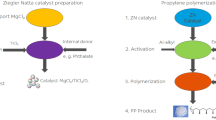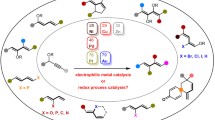Abstract
A number of chiral wholly aromatic polyesters (PEs) with phthalimido and flexible chiral unit in the backbone were prepared from a chiral synthesized diacid monomer, 5-(3-methyl-2-phthalimidylpentanoylamino)isophthalic acid (1), and various aromatic diols via the polyesterification reaction. The tosyl chloride/pyridine/N,N-dimethylformamide (DMF) system was used as a condensing agent. All of the these polymers having bulky phthalimido and amino acid functionalities in the side chain showed excellent solubility and readily dissolved in various solvents such as N-methyl-2-pyrrolidinone, N,N-dimethylacetamide and DMF. Since, these chiral polymers have natural amino acids in the polymer architecture, they are expected to be biodegradable and therefore may be classified under eco-friendly polymers. They had useful levels of thermal stability associated with excellent solubility. Thermogravimetric analysis (TGA) showed that the obtained PEs are rather thermally stable, 10% weight loss temperatures in excess of 317°C, and char yields at 700°C in the nitrogen atmosphere higher than 24%. The resulting polymers were obtained in good yields with inherent viscosities ranging between 0.22 and 0.56 dL/g and were characterized with FT-IR, 1H-NMR, elemental and TGA techniques.





Similar content being viewed by others
References
Bajgai MP, Aryal S, Lee DR, Park SJ, Kim HY (2008) Physicochemical characterization of self-assembled poly(ε-caprolactone) grafted dextran nanoparticles. Colloid Polym Sci 286:517–524
Barroso MN, Cerutti ES, Rodriguez AM, Jauregui EA, Farkas O, Perczel A, Enriz RD (2001) Side-chain conformations for selected backbone conformations of N-acetyl-l-isoleucine-N-methylamide and N-acetyl-l-nor-isoleucine-N-methylamide. An exploratory ab initio study. J Mol Struct (Theochem) 548:21–37
Bikiaris DN, Achilias DS (2008) Synthesis of poly(alkylene succinate) biodegradable polyesters, Part II: mathematical modelling of the polycondensation reaction. Polymer 49:3677–3685
Bordes P, Pollet E, Averous L (2009) Nano-biocomposites: biodegradable polyester/nanoclay systems. Prog Polym Sci 34:125–155
Bucio E, Fitch JW, Venumbaka SR, Cassidy PE (2005) Synthesis and properties of aliphatic spirodilactam diphenol containing polyesters. Polymer 46:3971–3974
Chen J, Zhou Y, Nan Q, Ye X, Sun Y, Zhang F, Wang Z (2007) Preparation and properties of optically active polyurethane/TiO2 nanocomposites derived from optically pure 1,1′-binaphthyl. Eur Polym J 43:4151–4159
Doi M, Yamaoka I, Fukunaga T, Nakayama M (2003) Isoleucine, a potent plasma glucose lowering amino acid, stimulates glucose uptake in C2C12 myotubes. Biochem Biophys Res Commun 312:1111–1117
Edlund U, Albertsson AC (2003) Polyesters based on diacid monomers. Adv Drug Deliver Rev 55:585–609
Feldman D, Barbalata A (1996) Synthetic polymers, technology, properties, applications. Chapman and Hall, London
Ferrero E, Espeso JF, Campa JGDL, Abajo JD, Lozano AE (2002) Synthesis and characterization of aromatic polyamides containing alkylphthalimido pendent groups. J Polym Sci Part A Polym Chem 40:3711–3724
Flores A, Balta Calleja FJ (1998) Mechanical study of sintered aromatic polyesters as revealed by microindentation measurements. J Mater Sci 33:3567–3571
Higashi F, Tobe A (2001) A new polycondensation involving dicarboxylic acids with differently activated carboxyl groups by TsCl/DMF/Py. Macromol Chem Phys 202:745–749
Hwang KJ, Park JW, Kim I, Ha CS (2006) Effect of a compatibilizer on the microstructure and properties of partially biodegradable LDPE/aliphatic polyester/organoclay nanocomposites. Macromol Res 14:179–186
Itsuno S (2005) Chiral polymer synthesis by means of repeated asymmetric reaction. Prog Polym Sci 30:540–558
Kawabe M, Sano M, Hagiwara A, Tamano S, Suzuki S, Shirai T (2006) Lack of carcinogenicity of l-isoleucine in F344/DuCrj rats. Food Chem Toxicol 44:278–285
Khang G, Rhee JM, Jeong JK, Lee JS, Kim MS, Cho SH, Lee HB (2003) Local drug delivery system using biodegradable polymers. Macromol Res 11:207–223
Kini AK, Farokhi SA, Nandibewoor ST (2002) A comparative study of ruthenium(III) catalysed oxidation of l-leucine and l-isoleucine by alkaline permanganate. A kinetic and mechanistic approach. Transit Metal Chem 27:532–540
Koyama E, Sanda F, Endo T (1997) Polycondensations of hydroxycarboxylic acids derived from optically active aminoalcohols and acid anhydrides—syntheses of functional poly(ester-amide)s. J Polym Sci Part A Polym Chem 35:345–352
Kumar R, Tyagi R, Parmar VS, Samuelson LA, Kumar J, Watterson AC (2003) Enzymatic synthesis of multi-component copolymers and their structural characterization. Mol Divers 6:287–295
Liaw DJ, Chen PS (1996) Preparation and properties of polyesters derived from 4,4′-sulfonyl dibenzoyl chloride by solution polycondensation. J Polym Sci Part A Polym Chem 34:885–891
Liaw DJ, Hsu JJ, Liaw BY (2001) Synthesis and characterization of new soluble cardo polyesters derived from 1, 1-bis-[4-(4-chlorocarboxyphenoxy)phenyl]-4-tert-butylcyclohexane with various bisphenols by solution polycondensation. J Polym Sci Part A Polym Chem 39:2951–2956
Liaw DJ, Fan CL, Lin CC, Wang KL (2004) Synthesis and characterization of new soluble poly(esterimide)s containing noncoplanar 2,2′-dimethyl-4,4′-biphenylene unit. J Appl Polym Sci 92:2486–2493
Mallakpour S, Khani M (2007) Novel optically active poly(amide-imide)s derived from N-trimellitylimido-l-isoleucine and different diisocyanates. Polym Bull 59(5):587–596
Mallakpour S, Kolahdoozan M (2006) Preparation and characterization of novel optically active poly(amide-ester-imide)s based on bis(p-aminobenzoic acid)-N-trimellitylimido-S-valine via direct polyesterification. Iran Polym J 15:307–315
Mallakpour S, Sepehri S (2008) Synthesis and characterization of new optically active polyesters by step-growth polymerization of novel aromatic (2S)-4-[(4-methyl-2-phthalimidyl-pentanoylamino)benzoylamino]isophthalic acid with aromatic diols. J Appl Polym Sci 110(5):2942–2949
Mallakpour S, Seyedjamali S (2008) Synthesis and characterization of novel organosoluble and optically active aromatic polyesters containing l-methionine and phthalimide pendent groups. Amino Acids 34(4):531–538
Mallakpour S, Seyedjamali H (2009) Fast synthesis of optically active polyamides containing l-methionine linkages in ionic liquid via a microwave-assisted process. Colloid Polym Sci 287:1111–1116
Mallakpour S, Taghavi M (2008) A facile, microwave-assisted synthesis of novel optically active polyamides derived from 5-(3-methyl-2-phthalimidylpentanoylamino) isophthalic acid and different diisocyanates. Eur Polym J 44:87–97
Mallakpour S, Zadehnazari A (2010) Microwave irradiation as a versatile tool for increasing reaction rates and yields in synthesis of optically active polyamides containing flexible l-leucine amino acid. Amino Acid (in press)
Mamer OA (2001) Initial catabolic steps of isoleucine, the R-pathway and the origin of alloisoleucine. J Chromatogr B 758:49–55
Murin R, Mohammadi G, Leibfritz D, Hamprecht B (2009) Glial metabolism of isoleucine. Neurochem Res 34:194–204
Odian G (2004) Principles of polymerization. Wiley Interscience, New York
Okada M (2002) Chemical syntheses of biodegradable polymers. Prog Polym Sci 27:87–133
Okamoto Y, Nakano T (1994) Asymmetric polymerization. Chem Rev 94:349–372
Pan P, Inoue Y (2009) Polymorphism and isomorphism in biodegradable polyesters. Prog Polym Sci 34:605–640
Peng Z, Fang J, Li J, Liu L, Du G, Chen J, Wang X, Ning J, Cai L (2009) Combined dissolved oxygen and pH control strategy to improve the fermentative production of l-isoleucine by Brevibacterium lactofermentum. Bioprocess Biosyst Eng (in press)
Sahm H, Eggeling L, Morbach S, Eikmanns B (1999) Construction of l-isoleucine overproducing strains of Corynebacterium glutamicum. Naturwissenschaften 86:33–38
Samui AB, Ratna D, Chavan JG, Deb PC (2002) Modification of epoxy resin with optically active carboxylic acid. J Appl Polym Sci 86:2523–2529
Sava I, Iosip MD, Bruma M, Hamciuc C, Robison J, Okrasa L, Pakula T (2003) Aromatic polyamides with pendent acetoxybenzamide groups and thin films made therefrom. Eur Polym J 39:725–738
Tamami B, Yeganeh H, Kohmareh GA (2004) Synthesis and characterization of novel polyesters derived from 4-aryl-2,6-bis(4-chlorocarbonyl phenyl) pyridines and various aromatic diols. Eur Polym J 40:1651–1657
Tawfik SY, Asaad JN, Sabaa MW (2003) Effect of polyester backbone structure on the cured products properties. Polym Test 22:747–759
Vijayakumar CT, Sivasamy P, Rajkumar T (2007) Synthesis and characterization of 1,3-bis(2-hydroxyethoxy) benzene based saturated and unsaturated polyesters. Eur Polym J 43:3028–3035
Zhang S, Li Y, Yin D, Wang X, Zhao X, Shao Y, Yang S (2005) Study on synthesis and characterization of novel polyimides derived from 2, 6-bis(3-aminobenzoyl) pyridine. Eur Polym J 41:1097–1107
Acknowledgments
We wish to express our gratitude to the Research Affairs Division, Isfahan University of Technology (IUT), Isfahan, for partial financial support. Further financial support from National Elite Foundation (NEF) and Center of Excellency in Sensors and Green Chemistry Research (IUT) is gratefully acknowledged. We also like to thank Dr Z. Rafiee and Mr. M. Dinari.
Author information
Authors and Affiliations
Corresponding author
Rights and permissions
About this article
Cite this article
Mallakpour, S., Khani, M. Construction of chiral polyesters from polycondensation of multifunctional monomer containing both flexible amino acid and rigid pendant groups with aromatic diols. Amino Acids 39, 841–848 (2010). https://doi.org/10.1007/s00726-010-0539-x
Received:
Accepted:
Published:
Issue Date:
DOI: https://doi.org/10.1007/s00726-010-0539-x




